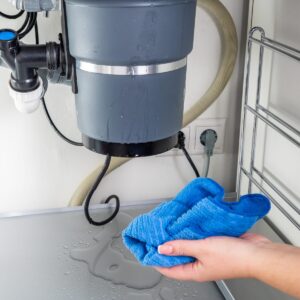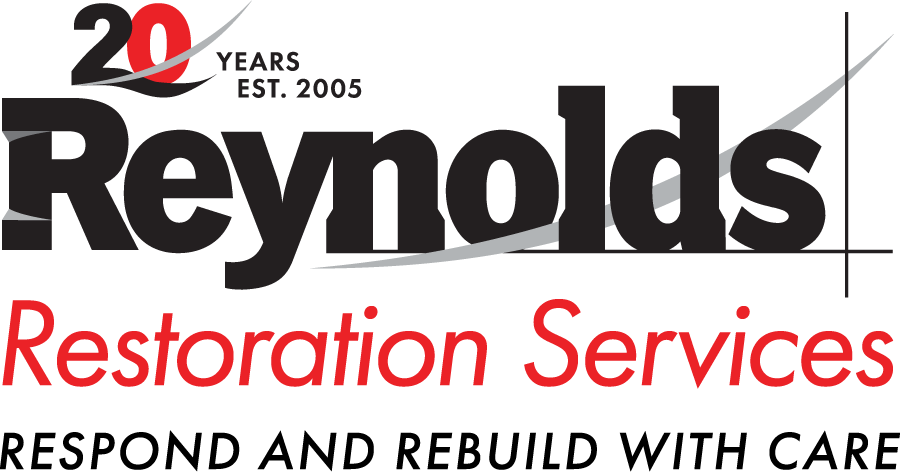
The good news is that with a little awareness and regular maintenance, many of these issues can be caught before they spiral out of control. Let’s look at the appliances most likely to cause leaks, how to spot the warning signs early, what to do if you discover water damage, and how Reynolds Restoration Services can help when cleanup goes beyond DIY.
Common Appliances That Cause Hidden Leaks
Appliances are one of the top sources of household water damage, but because they’re tucked into corners or hidden behind cabinets, leaks often go unnoticed until it’s too late. Keep your eyes on the usual suspects:
- Refrigerators & Ice Makers – That small water line feeding your ice maker can crack, loosen, or leak at the connection. Condensation pans may also overflow. Left unchecked, water can sneak beneath flooring, causing warping or mold growth.
- Dishwashers – Over time, door seals wear out, drain hoses loosen, and internal parts fail. Because dishwashers are built into cabinetry, leaks often stay hidden until you notice musty odors or damaged wood nearby.
- Washing Machines – Washer hoses are under constant water pressure. As they age, they can crack or even burst, releasing gallons of water in a matter of minutes. Even small drips behind the machine can saturate drywall or subflooring.
- Water Heaters – Tanks eventually corrode, sediment builds up, and pressure valves fail over time. What starts as a slow drip can quickly escalate into a ruptured tank that floods an entire room.
- Air Conditioners (HVAC systems) – Condensate drain lines and pans clog easily. If your unit is in the attic or basement, overflow can quietly soak ceilings, walls, or insulation before you realize there’s an issue.
- Garbage Disposals – Seals and connections can wear out over time, leading to slow leaks under the sink. Because these leaks often drip into cabinets, they can go unnoticed until you see warped wood, mold, or musty odors. Regularly inspect the unit and surrounding plumbing to catch issues early.
How to Detect Hidden Appliance Leaks Early
Most hidden appliance leaks don’t start as dramatic floods; they creep in slowly. Catching them early can save you thousands in repairs. Look for these red flags:
- Moisture or puddles near appliances – Even small puddles are a sign that something’s wrong.
- Warped flooring or stained walls/cabinets – Water seeps in fast, leaving soft spots, bubbling paint, or discoloration.
- Musty or moldy odors – Dampness promotes mold growth. If your laundry room or kitchen smells musty, investigate.
- Rust or corrosion on fittings – Rusty connections signal a slow leak that may be spreading.
- Sudden spikes in water bills – If your usage hasn’t changed but your bill has, a hidden leak could be running nonstop.
Preventing and Responding to Hidden Appliance Leaks
The best defense is prevention. But if a leak does happen, knowing how to act quickly can make all the difference.
Prevention tips:
- Inspect hoses and connections – Replace washer and dishwasher hoses every 5–7 years. Upgrade to braided stainless steel for added durability.
- Check seals and gaskets – Fridge and dishwasher seals wear out over time. Swap them out if you notice cracking or gaps.
- Maintain HVAC lines and pans – Clear out clogs annually to prevent attic or basement overflows.
- Locate shut-off valves – Make sure you know where each appliance’s water shut-off valve is located. Quick action can limit damage.
- Never ignore small drips – A “minor” leak often means bigger damage is already happening out of sight.
If a leak happens:
- Shut off the water supply immediately to stop additional flooding.
- Clean up standing water quickly, but remember moisture often seeps into hidden areas.
- Document everything with photos and notes. This will help with insurance claims and repair planning.
- Call in professionals for drying, dehumidification, and repairs. Hidden water can cause mold and structural issues that DIY cleanups miss.
Why Work With Reynolds Restoration Services
Appliance leaks may seem like a nuisance at first, but the damage they leave behind can be extensive and dangerous if ignored. Water can weaken structural supports, warp flooring, and foster mold growth that affects both your health and your home’s value.
At Reynolds Restoration Services, we offer comprehensive solutions for appliance-related water damage, including:
- Water extraction and industrial drying to stop moisture from spreading and protect your home’s structure.
- Mold prevention and remediation to ensure your home remains safe and healthy.
- Structural repair and reconstruction for walls, floors, cabinetry, and more.
- 24/7 emergency response because leaks don’t wait for business hours.
With more than 20 years of experience, we’ve helped homeowners across Pennsylvania, Maryland, and Delaware recover quickly and completely from appliance leaks.
A drip behind your refrigerator or washer may not feel urgent, but left unchecked, it can lead to thousands of dollars in damage. Stay alert to the warning signs, keep up with routine maintenance, and don’t hesitate to bring in professionals if something seems off.
Reynolds Restoration Services is here around the clock to handle leaks of all sizes, helping you clean up quickly, prevent further damage, and restore your home with care.

President of Reynolds Restoration Services. Over 20 years of experience in the emergency restoration industry.

